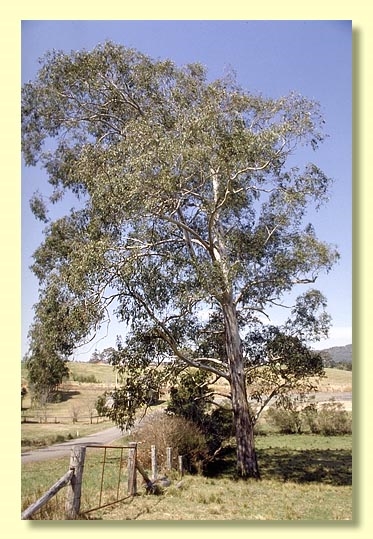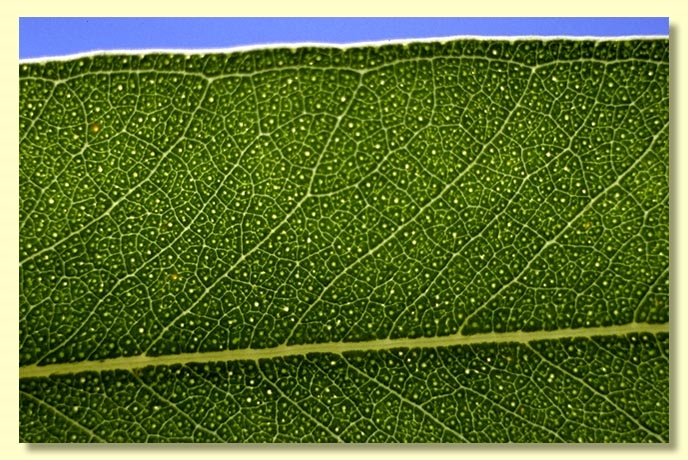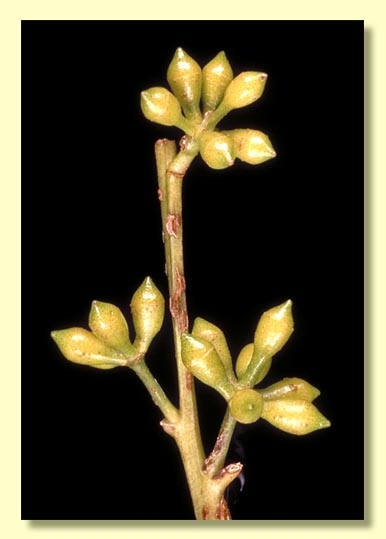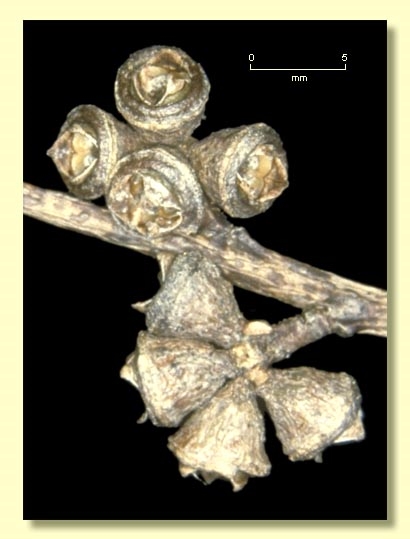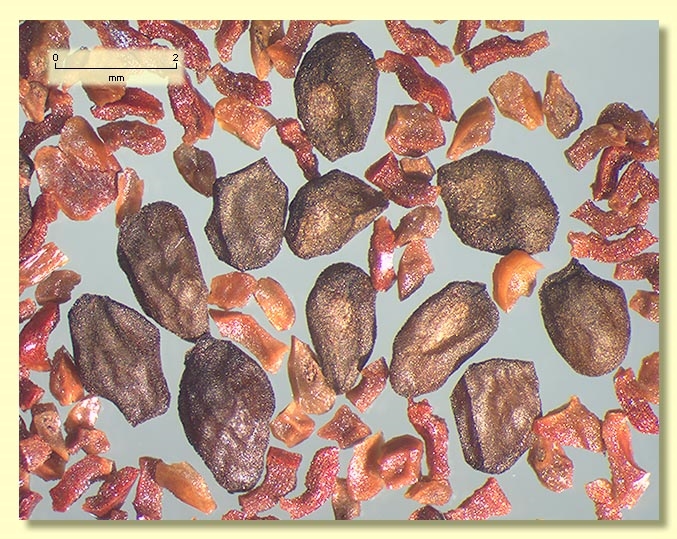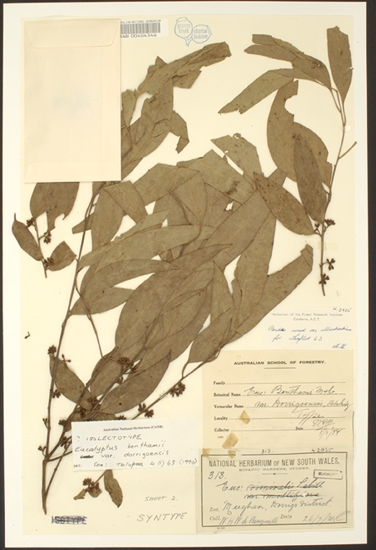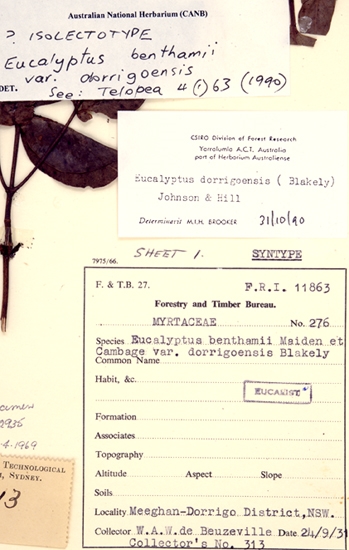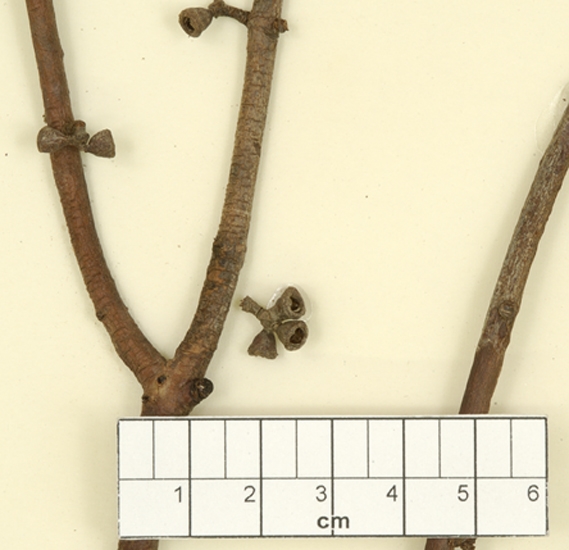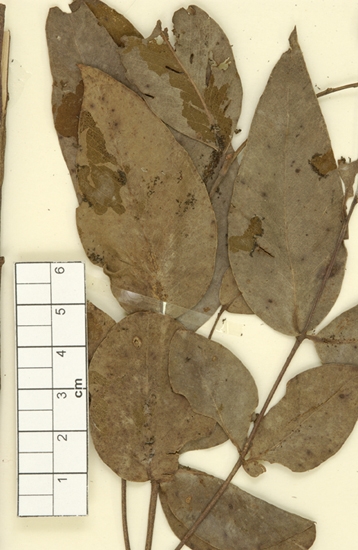Euclid - Online edition
Eucalyptus dorrigoensis
Eucalyptus | Symphyomyrtus | Maidenaria | Triangulares | Microcarpae
Bark smooth throughout or with some grey to grey-brown slabs of rough bark persisting on base of trunk; smooth bark sometimes slightly powdery, white, cream, pink or grey, often with ribbons of decorticated bark in the upper branches.
Juvenile growth (coppice or field seedlings to 50 cm): stem rounded in cross-section, warty; juvenile leaves opposite for many pairs, sessile, ovate to broadly lanceolate, 3.5–8 cm long, 1.3–4 cm wide, base amplexicaul at first then rounded, dull, green to blue-green or slightly glaucous.
Adult leaves alternate, petiole 0.5–2.5 cm long; blade lanceolate to falcate, 6–22 cm long, 1.2–2.7 cm wide, base tapering to petiole, concolorous, glossy or dull, green to grey-green, side-veins greater than 45° to midrib, moderately to densely and finely reticulate, intramarginal vein parallel to and just within margin, oil glands numerous, island.
Inflorescence axillary unbranched, peduncles 0.4–1 cm long, buds 7 per umbel, pedicels 0.1–0.3 cm long. Mature buds ovoid, 0.4–0.5 cm long, 0.2–0.3 cm wide, green, scar present, operculum conical, stamens inflexed, anthers cuboid or cuneate, versatile, dorsifixed, dehiscing by longitudinal slits (non-confluent), style long, stigma blunt, locules 3 or 4, the placentae each with 4 vertical ovule rows. Flowers white.
Fruit sessile or pedicellate (pedicels to 0.2 cm long), cup-shaped, obconical or hemispherical, 0.3–0.4 cm long, 0.4–0.5 cm wide, disc raised-convex, or disc level, valves 3 or 4, exserted or near rim level.
Seeds black or brown, 1–2 mm long, ovoid or flattened-ovoid, lacunose, dorsal surface shallowly pitted, hilum ventral.
Cultivated seedlings (measured at ca node 10): cotyledons bilobed; stems rounded in cross-section, warty; leaves sessile and opposite for at least 15 nodes, lanceolate, 3.5–8 cm long, 1.3–3 cm wide, base amplexicaul, apex rounded or pointed dull, green, new tip growth slightly waxy.
Flowering has been recorded in May.
An erect medium-sized to tall, smooth-barked tree of very restricted distribution near Dorrigo on the Northern Tablelands of New South Wales.
E. dorrigoensis differs from other seven-budded species of the Northern Tablelands by the many pairs of sessile, opposite, ovate to broadly lanceolate, blue-green to glaucous juvenile leaves and the mostly dull adult leaves. It was originally described as a variety of E. benthamii of the Blue Mountains and south along the Nepean River, but which differs most conspicuously in the scarcely dehiscent outer operculum.
Eucalyptus dorrigoensis belongs in Eucalyptus subgenus Symphyomyrtus section Maidenaria, a large group of species more or less restricted to south-eastern Australia, characterised by bilobed cotyledons, simple axillary inflorescences, buds with two opercula, stamens with versatile anthers and flattened seeds with a ventral hilum. Within this section E. dorrigoensis and 3 other species form series Microcarpae diagnosed by the smooth white bark, non-swampy habitat, and small, rather flat-topped fruit.
E. dorrigoensis has sessile rather than the shortly petiolate juvenile leaves of the 3 other species in this series, viz. E. scoparia, E. mannifera (with 3 subspecies), and E. elliptica.

